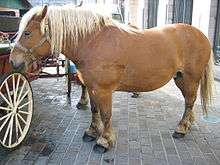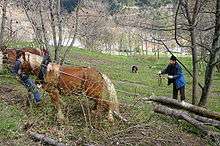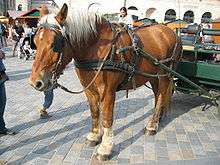Comtois horse
The Comtois horse is a draft horse that originated in the Jura Mountains on the border between France and Switzerland.
 Comtois horse | |
| Country of origin | France |
|---|---|
| Traits | |
| Distinguishing features | Light draft horse build, little feathering, chestnut with flaxen mane and tail |
Characteristics
The Comtois is a light draft horse, with a large head, straight neck, stocky and powerful body and deep girth. They have long, straight backs and short, strong legs with a little feathering and muscular hindquarters.[1] The Comtois sometimes shows a tendency towards sickle hocks. These horses are generally bay silver, but they can also be black silver, bay, black, and chestnut. They usually stand 1.50–1.65 metres (14.3–16.1 hands) high and weigh 650–800 kg (1,430–1,760 lb).[2]
History

The Comtois horse breed is an old breed of horse that is believed to have descended from horses brought by the Burgundians of northern Germany to France during the fourth century.[1] It is believed that they have been bred in Franche-Comté and in the Jura Mountains since the sixth century. In the Middle Ages they were used as war horses.[3] They were bred in Franche-Comté and in the Jura Mountains[1] In the 19th century, other draft horses such as the Norman, Boulonnais, and Percheron were bred into the Comtois, and more recently the Ardennes was used to produce a stronger horse with better legs. Today, they are second only to the Belgian draft horse in number in France.[1]
Uses

In the sixteenth century, these horses were used as a cavalry and artillery horse, and were present in the armies of Louis XIV and later Napoleon Bonaparte. The Comtois is used today for hauling wood in the pine forests of the Jura in the mountainous regions of the Massif Central, and for working in the vineyards in the Arbois area.[1] They are also bred for the French horsemeat industry.
References
- "Comtois". International Museum of the Horse. Archived from the original on October 23, 2007. Retrieved December 17, 2007.
- Le Comtois Association Nationale du Cheval de Trait Comtois. Les Haras Nationaux 2010 (in French) Accessed August 2011
- Bongianni, Maurizio (1988). Simon & Schuster's Guide to Horses and Ponies. Simon & Schuster, Inc. pp. 89. ISBN 0-671-66068-3.